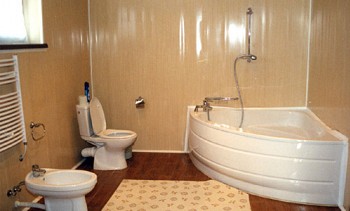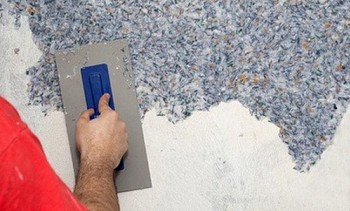Thinking about the repair, we always want to get an excellent result, and at the same time do without unnecessary expenses and meet the minimum time. Another important point is that the repair work does not cause a lot of trouble, does not leave dirt and does not interfere much with the neighbors.
An excellent solution in this case is the installation of plastic panels. Our instructions will help you understand how to fix plastic panels. They are easily mounted on the walls or ceiling, and for this you do not need to level the surface in advance.

Content:
- Essential tool and pre-training
- Features of installation and procedure
- Video: Installation of lathing, accessories and PVC panels
- Features of the installation of plastic panels on the walls
- Features of the installation of plastic panels on the ceiling
- Useful tips for installing plastic panels
- Video: Wall and ceiling decoration of a bathroom with PVC panels
Plastic panels are easy to clean and ideal for rooms with high humidity (bathroom, sauna, boiler room). A variety of colors and textures will help to create a unique and cozy interior. To install such panels, it is enough to have several tools on hand.
Essential tool and pre-training
The tools necessary for attaching plastic panels can be found in almost every home:
- electric drill;
- wood hacksaw;
- scissors and a hacksaw for metal;
- screwdriver or screwdriver;
- tape measure, building level, pencil or marker;
- hammer, stapler;
- ladder.
First, use a tape measure to measure the working surface, this will allow you to correctly calculate the required amount of materials.
The surface must be freed from wallpaper. If the panels will stick, the walls or tiles must be cleaned of paint and dust.
Before installation, it is recommended to withstand plastic panels for at least half an hour at room temperature. Do not rush to remove the protective film before the end of installation work, it will help maintain the presentation of the panels.
Features of installation and procedure
The panels are fastened either directly to the wall or to a pre-prepared crate. For wall mounting, it must be perfectly flat. The crate is a wooden bars or slats that are screwed to the surface at a certain distance from each other. For walls, the width between the slats should not exceed 30 - 40 cm, for the ceiling - not more than 30 cm. The laths for the battens are mounted perpendicular to the wall, relative to the direction of the panels.
If the wall to which the slats are attached is wooden or any other into which self-tapping screws are easily screwed, then it is best to use them to fasten the bars. If the wall is concrete or brick, then it is best to fasten the bars with dowels, nails or using ordinary dowels and screws.

An example of fastening the battens under plastic panels.
Before you begin, you must understand how to properly attach plastic panels to the wall.
- If you decide to fasten the panels to the crate with nails, keep in mind that the reuse of the material will be impossible, since, most likely, the panel will be damaged during dismantling.
- The best way of fastening - with the help of clamps.
- But the use of brackets that are driven with a special stapler is also a good option.
- Another good option for attaching panels is self-tapping screws.

The most common ways to attach plastic panels.
After you have decided on the method of fastening the panels, you need to do the following:
First install the accessories: the final element, the outer or inner corner.If the panel closes the wall to the ceiling, then fix the ceiling plinth to the top beam.

Available accessories for plastic panels.
Insert the panel into the fastener with a narrow fastening shelf. The panel is fixed on the side of the wide mounting shelf with nails or brackets.

After making sure that the first panel is installed evenly, insert the next, narrow end into the groove of the previous panel. Try to mount the panels tightly to each other.

Installation of the necessary fittings and the first plastic panel.
The last plastic panel that completes the row needs to be firmly inserted between the final element and the previous panel. If the panel needs to be reduced in width, then cut off the excess with a knife, moving along the panel.
Video: Installation of lathing, accessories and PVC panels
Features of the installation of plastic panels on the walls
If the room is dry and the walls are even, then the panels can be mounted directly on the wall without using a crate.

Fastening panels to glue directly on the walls without using a crate.
In a room with high humidity, a plastic or metal mounting profile should be used as a crate. In this case, the panels are attached to the rails with special clips, which greatly facilitates the installation and dismantling of the structure.

Fastening panels using a plastic profile using special clips.
Consideration should be given to the expansion of the material when the temperature changes, so when adjusting the panels in height, leave a small gap. If you use a wide beam for the crate, then in the resulting space between the wall and the panels you can put insulation or soundproofing material.
Features of the installation of plastic panels on the ceiling
Now consider the ways to fix plastic panels to the ceiling. Before installation, it is necessary to determine the distance between the panels and the ceiling. This gap will depend on the type of lighting. If you plan to install built-in lights, then the distance should be at least 10-15 cm, so you can completely hide the wiring. Mark the places of the fixtures with a pencil in advance, cut out the holes and install the socles of the lighting fixtures.

Metal lath for mounting plastic panels on the ceiling in the bathroom.
Next, you perform the same steps as when installing panels on the walls. In a room with a flat ceiling, you can do without a crate. Before starting work, install the ceiling plinth on three walls. Use the building level to evenly position the panels.
When installing plastic panels in a room with high humidity, fill the ceiling gaps with silicone sealant to achieve complete waterproofness.
Useful tips for installing plastic panels:
1. Cut and drill the panels by turning them face up. For cutting use a hacksaw for metal, a hand saw or a construction knife. Always wear special glasses to protect your eyes.
2. Apply glue directly to the wall. Use a straight line to draw a grid without leaving empty areas. Use only special construction liquid glue.
3. When driving nails into the panel during installation, be careful not to hit the surface with a hammer, otherwise dents will remain.
4. Clean plastic panels with soapy water. Do not use abrasive cleaners, coarse washcloths or solvent-based cleaners.
Now you know how to fix plastic panels to the wall and how to care for them. Installation of plastic panels does not require much time and can be done by any beginner. By choosing this easy-to-install material, you can create a unique interior with your own hands. Among the variety of panels that imitate stone, wood, paper of various colors, you will definitely find an option for everyone.
Be sure to look at the video below, it very clearly shows the process of installing plastic panels.
Video: Wall and ceiling decoration of a bathroom with PVC panels


